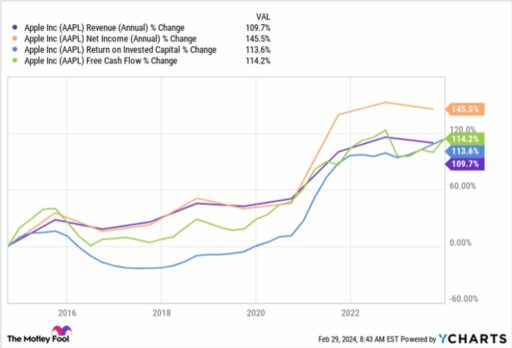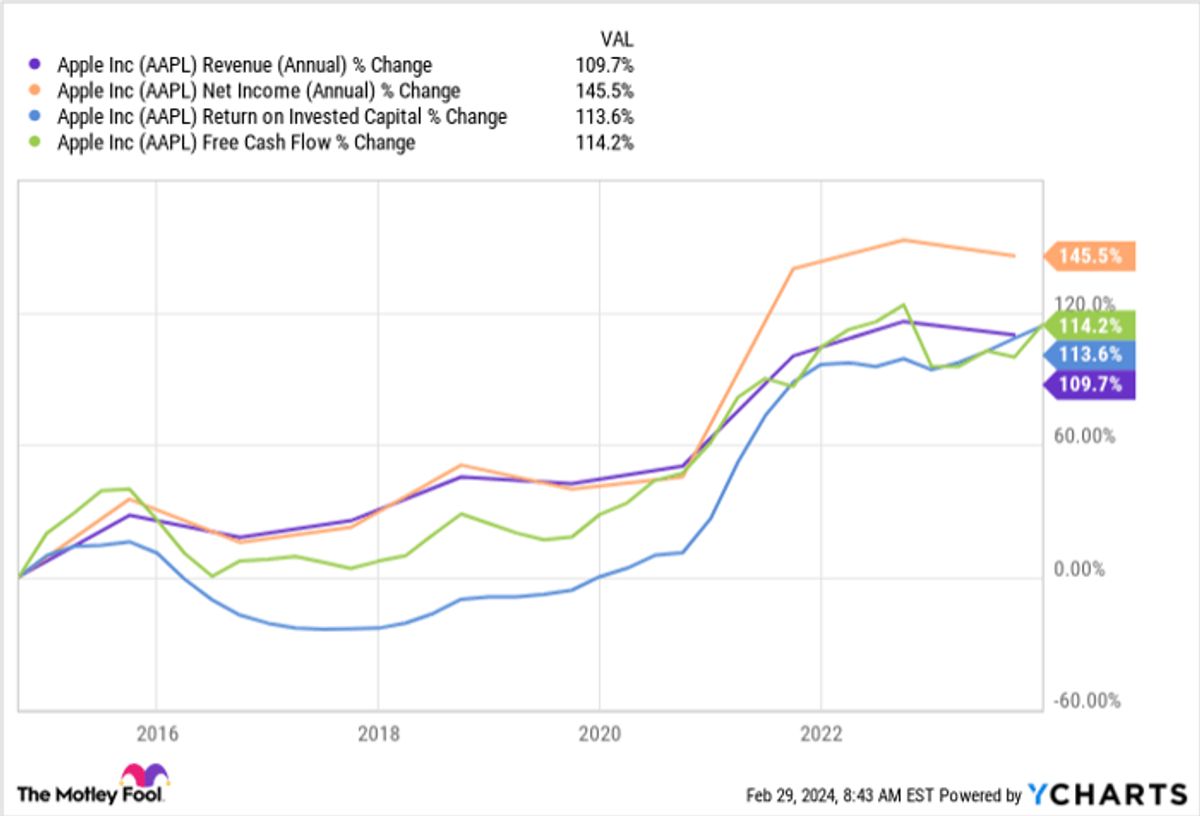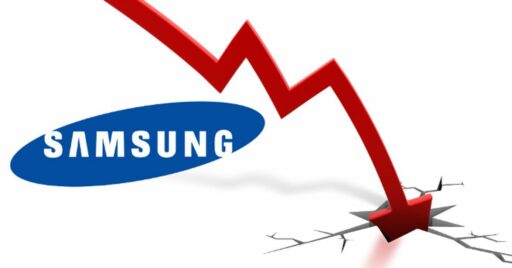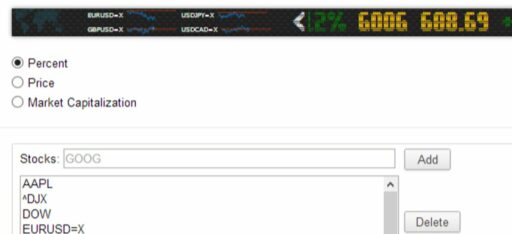Apple Inc. (AAPL) has always been at the forefront of innovation and market trends, and its stock reflects the dynamic nature of the company. As investors seek to navigate the complex investment landscape that AAPL presents, it’s crucial to understand the various factors influencing its performance. From financial results and market analysis to strategic decisions and future projections, this article aims to provide a comprehensive overview of AAPL’s potential as an investment opportunity.
Key Takeaways
- AAPL’s recent financial performance indicates potential for a bullish market trend, with a strong Q1 revenue and earnings beat despite shrinking China sales.
- Technical analysis suggests that Apple’s stock is showing early signs of rejoining bull market leadership, with a low Schaeffer’s Volatility Index hinting at options affordability.
- Short-term options traders exhibit a bullish outlook on AAPL, with the post-earnings dip seen as a buying opportunity amidst analyst target adjustments.
- Strategic moves, including the shift in production and the cancellation of the EV program, are poised to impact both AAPL and related industries, signaling a potential shift in investment focus.
- Investors may consider diversifying into small cap stocks and employing strategies that account for market manipulation when investing in AAPL for long-term growth.
Analyzing Apple’s Recent Financial Performance

Understanding AAPL’s Q1 Revenue and Earnings Beat
Apple’s first quarter financial results have made a clear statement: the tech giant continues to grow despite market challenges. The company reported earnings per share (EPS) of $2.18, surpassing the estimated $2.10, and total revenue reached $119.58 billion, beating estimates of $117.91 billion.
Here’s a breakdown of Apple’s revenue by product category:
| Product Category | Revenue (Billion $) | Estimated Revenue (Billion $) |
|---|---|---|
| iPhone | 69.70 | 67.82 |
| Mac | 7.78 | 7.73 |
| iPad | 7.02 | 7.33 |
| Other Products | 11.95 | 11.56 |
| Services | 23.12 | 23.35 |
Despite a notable downturn in China sales, Apple’s diverse portfolio has cushioned the impact, showcasing the company’s robust business model and ability to adapt to shifting market dynamics.
While the overall financial health of Apple appears strong, investors are cautiously observing the stock’s movement, particularly after a 3% dip in early trading post-earnings announcement. This cautious stance is a reminder of the ever-present volatility in the stock market, even for industry leaders like Apple.
The Impact of Shrinking China Sales on Apple’s Stock
Apple’s recent financial disclosures revealed a surprising downturn in sales within China, a critical market for the tech giant. Despite overall revenue and earnings surpassing expectations, Apple’s shares experienced a dip in response to the sales decline. The company’s performance in China is particularly concerning given the fierce competition from local brands, which have been gaining ground.
| Metric | Reported | Estimated |
|---|---|---|
| Earnings per Share (EPS) | $2.18 | $2.10 |
| Revenue | $119.58 billion | $117.91 billion |
| Services Revenue | $23.12 billion | $23.35 billion |
| Gross Margin | 45.9% | 45.3% |
The 13% drop in China sales is a stark contrast to the company’s overall success. Analysts have responded to this mixed financial picture with a range of price target adjustments, reflecting the uncertainty surrounding Apple’s future performance in the region.
The strength of the dollar against the Chinese yuan and the increasing market share of local competitors like Huawei are key factors in the sales decline. This has led to a bearish outlook among some investors, despite bullish sentiment in other areas of Apple’s business.
Analyst Price Target Adjustments Post-Earnings
Following Apple’s recent earnings announcement, a mixed reaction from analysts has led to a reshuffling of price targets for AAPL stock. Piper Sandler analyst Harsh Kumar adjusted his price target, reducing it from $205 to $190, reflecting a cautious stance on Apple’s future revenue and earnings. This sentiment was echoed by others, with a general trend of target reductions due to concerns over Apple’s performance, particularly in China.
Despite the downward revisions, some analysts remain optimistic, with Monness Crespi Hardt and Jefferies raising their targets to $200 and $205, respectively. This divergence in analyst opinions highlights the complexity of forecasting Apple’s stock trajectory in a volatile market.
The adjustments in analyst price targets post-earnings are indicative of the challenges and uncertainties that lie ahead for Apple, as it navigates through market fluctuations and regional sales dynamics.
Technical Analysis and Market Trends for AAPL

Interpreting the Daily Chart and Bull Market Signals
In the realm of technical analysis, Apple’s daily chart is hinting at a bullish resurgence, indicating potential leadership in the upcoming bull market. The chart reveals several key indicators that seasoned investors watch closely:
- The Accumulation/Distribution (AD) line is trending upwards, suggesting a strong accumulation phase by market makers.
- A consistent price support level around $180, providing a foundation for upward momentum.
- The appearance of a doji candlestick on Friday, often considered a sign of a possible trend reversal.
While retail traders may have experienced uncertainty, the recovery of AAPL’s stock price in the afternoon session underscores the resilience and potential for a bullish turnaround.
The market’s response to Apple’s financial maneuvers and product news is always dynamic. Keeping an eye on the daily chart and market signals can provide investors with an edge in anticipating AAPL’s next move.
The Significance of Apple’s Schaeffer’s Volatility Index
Apple’s stock performance is often scrutinized through various analytical lenses, one of which is the Schaeffer’s Volatility Index (SVI). The SVI is a measure that reflects the market’s expectations of future volatility based on options pricing. A lower SVI suggests that traders anticipate less volatility, which can be a signal of stable price movement ahead.
The SVI of Apple stock, currently at 19%, indicates a lower expectation of volatility compared to the majority of the past year. This could imply a period of relative calm for AAPL shares, potentially setting the stage for steady gains.
Historical data supports the significance of the SVI as a predictive tool. For instance, after similar low SVI readings, Apple’s stock price has often experienced an uptick. Here’s a quick look at the potential impact of the current SVI on AAPL’s price trajectory:
| Timeframe | Average Gain | Projected AAPL Price |
|---|---|---|
| 1 Month | 11.8% | $202.08 |
While past performance is not always indicative of future results, investors and traders closely monitor the SVI as part of their decision-making process.
Bearish Rising Wedge and PMO Negative Divergence
The technical analysis of AAPL stock reveals a concerning pattern: a bearish rising wedge formation has been identified, suggesting potential downward pressure on the stock price. This pattern is typically recognized by a narrowing price range between higher highs and higher lows, which often precedes a trend reversal.
The Price Momentum Oscillator (PMO), an important technical indicator, has shown a negative divergence as the stock price made new highs. This divergence indicates weakening momentum and could be a harbinger of a pullback.
Market participants should consider the following implications of these technical signals:
- The necessity for caution and close monitoring of AAPL’s stock for signs of a breakdown from the wedge pattern.
- Potential strategies to mitigate risk, such as setting stop-loss orders or reducing position sizes.
- The importance of diversifying portfolios to protect against sector-specific risks.
Options Trading and Investor Sentiment

The Bullish Outlook Among Short-term Options Traders
The sentiment among short-term options traders has shown a marked shift towards bullishness, particularly in the wake of Apple’s recent financial performance. This optimism is reflected in the Schaeffer’s put/call open interest ratio (SOIR), which is currently positioned in the low 17th percentile of its annual range. Such a low SOIR indicates that call options are being favored over puts, suggesting that traders are betting on AAPL’s stock to rise.
The volume of call trading has surged, with a notable focus on near-term strike prices. For instance, the 2/2 185-strike call has seen a flurry of activity, implying a collective expectation of an uptick in Apple’s stock value before the expiration of these options.
Despite the positive earnings report, AAPL’s stock experienced a dip, likely influenced by the contraction in China sales and adjustments in analyst price targets. However, this pullback has not deterred call traders, who appear to view it as a buying opportunity, as evidenced by the tripled intraday average volume of call transactions compared to puts.
Options Affordability and Potential for Speculation
The affordability of Apple’s options has made them an attractive vehicle for speculation among investors. Lower premiums on options contracts allow for greater leverage, enabling traders to amplify their exposure to AAPL’s stock movements without committing large amounts of capital.
Options trading volume for AAPL has shown a marked increase, indicating a heightened interest in speculative plays. This trend is particularly evident in the days following earnings announcements, where volatility can lead to significant price swings.
The ease of entry into the options market, coupled with the potential for high returns, has contributed to a speculative atmosphere where risk and reward are carefully weighed by market participants.
Here is a snapshot of recent options activity for AAPL:
| Option Type | Volume | Open Interest |
|---|---|---|
| Call | 150K | 200K |
| Put | 100K | 120K |
This table reflects the robust activity and the speculative nature of the options market for AAPL. Investors are advised to approach with caution, as the potential for both gains and losses is amplified in such an environment.
Investor Reactions to Apple’s Post-Earnings Dip
Following Apple’s earnings announcement, the market response was a mix of caution and opportunity. Investors digested the mixed signals, with a notable dip in Apple’s stock price, despite the company beating revenue and earnings estimates. The dip was attributed to a contraction in sales within China, a key market for Apple, leading to a 3% decline in stock value during early trading.
Short-term options traders, however, displayed a bullish stance, seizing the post-earnings dip as a buying opportunity. This sentiment was reflected in the increased activity among call traders, suggesting a belief in the stock’s resilience and potential for rebound.
| Metric | Reported | Estimated |
|---|---|---|
| EPS | $2.18 | $2.10 |
| Revenue | $119.58B | $117.91B |
Despite the immediate post-earnings dip, the underlying strength of Apple’s financial performance and the bullish sentiment among options traders may signal a favorable entry point for investors.
Analysts have adjusted their price targets in light of the recent developments, with some reducing their expectations and others raising them, indicating a divided outlook on Apple’s near-term stock trajectory.
Apple’s Strategic Moves and Industry Impact

Apple’s Production Shift and Its Implications
Apple’s strategic decision to diversify its production away from China marks a significant shift in its operational approach. This move is driven by the need to mitigate risks associated with over-reliance on a single region and to navigate geopolitical tensions. The implications of this shift are far-reaching, potentially affecting everything from supply chain logistics to regional economic dynamics.
- Supply Chain Resilience: Enhancing the robustness of Apple’s supply chain against global disruptions.
- Cost Implications: Potential increases in production costs due to new facility setups and labor market differences.
- Market Expansion: Opportunities to tap into new markets and labor pools.
- Geopolitical Strategy: A response to the changing geopolitical landscape and trade policies.
The transition to a more geographically dispersed production model is a proactive step that underscores Apple’s commitment to maintaining its market leadership and ensuring product availability. While the initial stages may involve challenges, the long-term benefits could solidify Apple’s competitive edge.
The Cancellation of Apple’s EV Program and Its Effects
The recent cancellation of Apple’s electric vehicle (EV) program has sent ripples through the tech and automotive industries. This decision marks the end of a decade-long initiative that promised to redefine the electric car landscape. The implications of this move are multifaceted, affecting not only Apple’s strategic direction but also the broader EV market.
- Apple’s shift away from EV development may redirect focus and resources to other innovative projects within the company.
- The EV industry could face a vacuum in anticipated competition, potentially altering market dynamics.
- Apple’s hardware engineers and car designers may transition to different roles, mitigating job losses.
The cessation of the EV program could be a strategic recalibration for Apple, as it reassesses its position in a rapidly evolving technological ecosystem.
While the full impact of this decision remains to be seen, it is clear that Apple’s withdrawal from the electric car race will have lasting consequences. The company’s pivot may also signal a broader industry trend, where tech giants reassess their commitments to capital-intensive ventures like automotive manufacturing.
Apple’s Position in the Evolving Tech Landscape
As the tech landscape continues to evolve, Apple’s strategic positioning is more critical than ever. With the AI race heating up, Apple is not only expanding its AI capabilities but also making significant strides in the smartphone market. In 2023, Apple grabbed the top spot in the smartphone market, achieving a record high market share despite an overall market contraction of 3.2%, as per IDC Tracker.
Apple’s AI advancements are not just about staying competitive; they’re about shaping the future of technology. The company’s focus on integrating AI into every aspect of their product lineup, from voice recognition to machine learning, is set to transform user experiences across all devices, including the upcoming iOS 18 and iPhone 16.
Apple’s investment in AI research and acquisitions of AI startups positions it at the forefront of innovation, ensuring a competitive edge in a rapidly changing industry.
The table below outlines Apple’s recent AI-related acquisitions, highlighting the company’s commitment to enhancing its AI ecosystem:
| Year | AI Startup Acquired | Focus Area |
|---|---|---|
| 2021 | Xnor.ai | Edge AI |
| 2022 | Voysis | Voice AI |
| 2023 | Inductiv | Data AI |
By securing top-tier talent and innovative technologies through these acquisitions, Apple is consolidating its presence in key AI domains and setting the stage for future developments.
Future Projections and Investment Strategies

Predicting AAPL’s Performance in the Coming Years
As investors look to the horizon, predicting the performance of AAPL stock becomes a blend of art and science. Coin Price Forecast suggests a bullish outlook, with an end-of-year target for 2023 at $196, indicating a year-to-year change of +51%. However, the journey there is expected to be modest, with a rise from today to year-end projected at just +1%.
The landscape for AAPL is not without its challenges. The company’s recent strategic shifts, including the move of production out of China and the shutdown of its EV program, may introduce volatility in the stock’s performance. Additionally, technical indicators such as the bearish rising wedge and PMO negative divergence signal caution among technical analysts.
Despite these concerns, historical patterns offer a glimmer of hope. After similar market conditions, AAPL has shown an average 11.8% gain one month later, suggesting potential for a rebound to record highs. The affordability of options and the current dip in AAPL’s stock price present opportunities for investors willing to speculate on the company’s ability to navigate these headwinds.
Strategies for Investing in AAPL Amid Market Manipulation
Investing in Apple (AAPL) amidst market manipulation requires a strategic approach that balances awareness and timing. Market maker manipulation has been egregious in 2024, with AAPL experiencing significant price fluctuations during trading hours. Investors should consider the following points when navigating these waters:
- Understand the patterns: Recognize the signs of manipulation, such as unusual price drops or gains during specific times of the day.
- Accumulation and support levels: Pay attention to the Accumulation/Distribution (AD) line and price support levels, which can indicate when market makers are accumulating shares.
- Timing your trades: Consider the historical data showing AAPL’s tendency to recover in the afternoon after morning sell-offs.
While market manipulation can be disconcerting, informed investors can use this to their advantage by identifying and acting on the underlying patterns.
It’s also crucial to monitor analyst sentiments and the broader market trends. Despite the challenges, AAPL’s stock has shown resilience, and strategic investors can find opportunities even in the face of manipulation.
The Case for Diversifying into Small Cap Stocks
While investing in AAPL provides stability, diversifying into small cap stocks can enhance a portfolio’s growth potential. Small cap stocks often offer higher growth rates due to their size and market position, which can lead to significant returns over time. However, they also come with higher volatility and risk, making them a suitable addition for investors willing to tolerate short-term fluctuations for long-term gains.
Diversification into small cap stocks can balance a portfolio, providing a hedge against market volatility and sector-specific downturns.
Investors should consider the following when adding small cap stocks to their portfolio:
- Assessing the risk tolerance and investment horizon
- Conducting thorough research on potential companies
- Monitoring the portfolio actively to manage risk
It’s crucial to remember that small cap stocks, while potentially lucrative, should complement rather than replace core holdings in established companies like Apple.
Conclusion
In navigating the investment landscape of Apple Inc. (AAPL), we’ve explored various indicators that suggest a complex yet potentially rewarding future. Despite recent challenges, including production shifts and the shutdown of its EV program, AAPL’s stock has shown resilience with signs of regaining its bull market leadership. Analysts present a mixed outlook, with some adjusting price targets and noting short-term bullishness among options traders. The technical analysis reveals a bearish rising wedge and negative divergence, yet historical patterns hint at possible gains. Investors considering AAPL must weigh these factors carefully, recognizing that while the prognosis may not point to immediate magnificence, the company’s track record and recent earnings beat indicate underlying strength. As AAPL navigates its current dip and broader market dynamics, the potential for a rebound to record highs remains a scenario worth watching, especially for those with a keen eye on market trends and the patience to endure short-term volatility.
Frequently Asked Questions
What recent financial achievements has Apple (AAPL) accomplished?
Apple has recently beaten its Q1 revenue and earnings estimates, indicating strong financial performance despite challenges such as shrinking China sales.
How is Apple’s stock responding to market trends?
AAPL is showing early signals of rejoining the bull market leadership, with technical analysis suggesting potential for a new record high, influenced by factors like the Schaeffer’s Volatility Index and price momentum.
What is the sentiment among options traders regarding AAPL stock?
Short-term options traders are displaying a bullish outlook on AAPL, with options being affordably priced and increased speculation following Apple’s post-earnings dip.
How are Apple’s strategic decisions affecting the industry?
Apple’s move to shift production out of China and the cancellation of its EV program are significant strategic decisions that are likely to impact both the company and the broader tech and EV industries.
What are future projections for AAPL’s stock performance?
Although AAPL may face challenges in the short term, it is predicted to regain its leadership role and contribute positively to large cap stocks. However, diversification into small cap stocks is also being recommended.
How should investors approach investing in AAPL given market manipulation?
Investors should consider strategies that account for market manipulation, such as monitoring market maker actions, and consider afternoon buying opportunities when AAPL shows strength.





